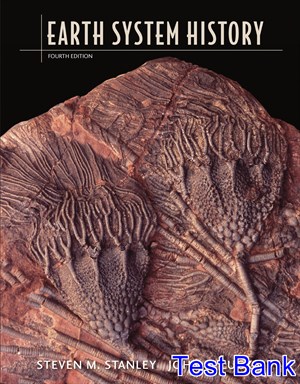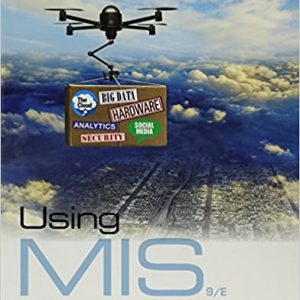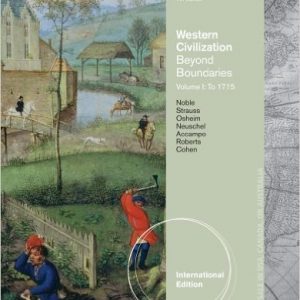This is completed downloadable of Earth System History 4th Edition Stanley Test Bank

Product Details:
- ISBN-10 : 1429255269
- ISBN-13 : 978-1429255264
- Author:
Steven Stanley’s classic textbook, now coauthored with John Luczaj, remains the only book for the historical geology course written from a truly integrated earth systems perspective. The thoroughly updated new edition includes important new coverage on mass extinctions, climate change, and Proterozoic history, plus a range of interactive studying and teaching tools.Congratulations to Steven Stanley
Dr. Steven M. Stanley is the recipient of the 2013 Geological Society of America (GSA) Penrose Medal, the Society’s highest honor. This medal, which is awarded for eminent research in pure geology, was presented at the GSA 125th Annual Meeting & Exposition.
Table of Content:
- Part I: Materials, Processes, and Principles
- CHAPTER 1 Earth as a System
- Exploring the Earth System
- The Principle of Actualism
- The Nature and Origin of Rocks
- Global Dating of the Rock Record
- Imaging Earth Below
- Plate Tectonics
- The Water Cycle
- Directional Change in Earth’s History
- Episodic Change in Earth’s History
- Chapter Summary
- Review Questions
- CHAPTER 2 Rock-Forming Minerals and Rocks
- The Structure of Minerals
- The Properties of Minerals
- Types of Rocks
- Chapter Summary
- Review Questions
- CHAPTER 3 The Diversity of Life
- Fossils and Chemical Remains of Ancient Life
- Taxonomic Groups
- Identifying Clades and Their Relationships
- Archaea and Bacteria: The Two Domains of Prokaryotes
- The Protists: A Paraphyletic Group of Eukaryotes
- Green Algae and Land Plants
- Opisthokonts: Fungi and Animals
- Chapter Summary
- Review Questions
- CHAPTER 4 Environments and Life
- Principles of Ecology
- The Atmosphere
- The Terrestrial Realm
- The Marine Realm
- Freshwater Environments
- Chapter Summary
- Review Questions
- CHAPTER 5 Sedimentary Environments
- Nonmarine Environments
- Marginal Marine and Open-Shelf Environments
- Deep-Sea Environments
- Chapter Summary
- Review Questions
- CHAPTER 6 Correlation and Dating of the Rock Record
- The Geologic Time Scale
- Stratigraphic Units
- Earth’s Absolute Age
- Event Stratigraphy
- Chapter Summary
- Review Questions
- CHAPTER 7 Evolution and the Fossil Record
- Adaptations
- Charles Darwin’s Contribution
- Genes, DNA, and Chromosomes
- Regulatory Genes and Patterns of Development
- Populations, Species, and Speciation
- Rates of Origination
- The Molecular Clock and Times of Origination
- Evolutionary Convergence
- Extinction
- Evolutionary Trends
- Chapter Summary
- Review Questions
- CHAPTER 8 The Theory of Plate Tectonics
- The History of Continental Drift Theory
- The Rise of Plate Tectonics
- Faulting and Volcanism along Plate Boundaries
- Plate Movements
- Chapter Summary
- Review Questions
- CHAPTER 9 Continental Tectonics and Mountain Chains
- The Rifting of Continents
- Bending and Flowing of Rocks
- Mountain Building
- Tectonics of Continental Interiors
- Chapter Summary
- Review Questions
- CHAPTER 10 Major Geochemical Cycles
- Chemical Reservoirs
- Carbon Dioxide, Oxygen, and Biological Processes
- Oxygen Isotopes, Climate, and the Water Cycle
- Use of Carbon Isotopes to Study Global Chemical Cycles
- Phanerozoic Trends in Atmospheric Carbon Dioxide
- Carbon and Oxygen Isotope Excursions
- Ocean Chemistry and Skeletal Mineralogy
- Chapter Summary
- Review Questions
- Part II: The Story of Earth
- CHAPTER 11 The Hadean and Archean Eons of Precambrian Time
- The Ages of the Planets and the Universe
- The Origin of the Solar System
- The Hadean Eon
- The Origin of Continental Crust
- The Archean Eon
- Greenstone Belts
- Earth System Shift 11-1 Large Cratons Appear near the End of Archean Time
- Evidence of Archean Life
- Chemical Evidence Bearing on the Origin of Life
- Atmospheric Oxygen
- Chapter Summary
- Review Questions
- CHAPTER 12 The Proterozoic Eon of Precambrian Time
- A Modern Style of Orogeny
- Global Events of the Paleoproterozoic and Mesoproterozoic
- The Beginnings of Animal Life
- Earth System Shift 12-1 The Great Oxidation Event
- Earth System Shift 12-2 Was There a Snowball Earth?
- The Expansion and Contraction of Continents
- The Assembly of North America
- The Assembly and Breakup of Neoproterozoic Supercontinents
- Chapter Summary
- Review Questions
- CHAPTER 13 The Early Paleozoic World
- The Cambrian Explosion of Life
- Earth System Shift 13-1 Skeletons Evolve in Many Animal Groups as Predators Diversify
- Ordovician Life
- Paleogeography of the Cambrian World
- Episodic Mass Extinctions of Cambrian Trilobites
- Ordovician Paleogeography, Climatic Change, and Mass Extinction
- Earth System Shift 13-2 Climatic Cooling Results in Glaciation and Mass Extinction
- Regional Events of Early Paleozoic Time
- Chapter Summary
- Review Questions
- CHAPTER 14 The Middle Paleozoic World
- Renewed Diversification of Life
- Earth System Shift 14-1 Plants Alter Landscapes and Open the Way for Vertebrates to Conquer the Land
- The Paleogeography of the Middle Paleozoic World
- Glaciation and a Mass Extinction
- Regional Events of Middle Paleozoic Time
- Earth System Shift 14-2 The Expansion of Plants over Land Causes Global Climatic Change, Glaciation,
- Chapter Summary
- Review Questions
- CHAPTER 15 The Late Paleozoic World
- Late Paleozoic Life
- Earth System Shift 15-1 Weakened Greenhouse Warming Results in a Great Ice Age
- Paleogeography of the Late Paleozoic World
- Earth System Shift 15-2 The Most Destructive of All Mass Extinctions Ends the Paleozoic Era
- Regional Events of Late Paleozoic Time
- Chapter Summary
- Review Questions
- CHAPTER 16 The Early Mesozoic Era
- Life in the Oceans: A New Biota
- Life on Land
- Earth System Shift 16-1 The Rise of the Dinosaurs: Why Were They So Successful?
- Earth System Shift 16-2 Volcanism and Mass Extinction
- The Paleogeography of the Early Mesozoic Era
- Tectonic Events in North America
- Chapter Summary
- Review Questions
- CHAPTER 17 The Cretaceous World
- Cretaceous Life
- Paleogeography of the Cretaceous World
- The Terminal Cretaceous Extinction
- North America in the Cretaceous World
- Earth System Shift 17-1 Death from Outer Space
- The Chalk Seas of Europe
- Chapter Summary
- Review Questions
- CHAPTER 18 The Paleogene World
- Life of the Paleogene
- Paleogene Climates
- Regional Events of Paleogene Time
- Earth System Shift 18-1 Global Cooling and Drying Begins
- Chapter Summary
- Review Questions
- CHAPTER 19 The Late Cenozoic World Before the Holocene
- Life of the Neogene Period
- The Modern Ice Age of the Northern Hemisphere
- Earth System Shift 19-1 Shockingly Rapid Climatic Shifts Occur during the Ice Age
- Regional Events of Neogene Time
- Human Evolution
- Earth System Shift 19-2 The Human Genus Arises at a Time of Sudden Climatic Change
- Chapter Summary
- Review Questions
- CHAPTER 20 The Retreat of Glaciers and the Holocene
- The Retreat of Glaciers
- Abrupt Global Events of the Latest Pleistocene and Early Holocene
- The Younger Dryas
- Earth System Shift 20-1 Evidence That a Comet Struck Earth, Causing the Younger Dryas Event, the Ext
- The First Americans
- A Sudden Extinction of Large Mammals
- Climatic Fluctuations of the Last 10,000 Years
- Sea Level Changes
- The Twentieth and Twenty-First Centuries: The Impact of Humans
- Chapter Summary
- Review Questions
- Appendix: Stratigraphic Stages
- Glossary
- A
- B
- C
- D
- E
- F
- G
- H
- I
- L
- M
- N
- O
- P
- Q
- R
- S
- T
- U
- V
- W
- X
- Z
- Index
- A
- B
- C
- D
- E
- F
- G
- H
- I
- J
- K
- L
- M
- N
- O
- P
- Q
- R
- S
- T
- U
- V
- W
- Y
- Z





